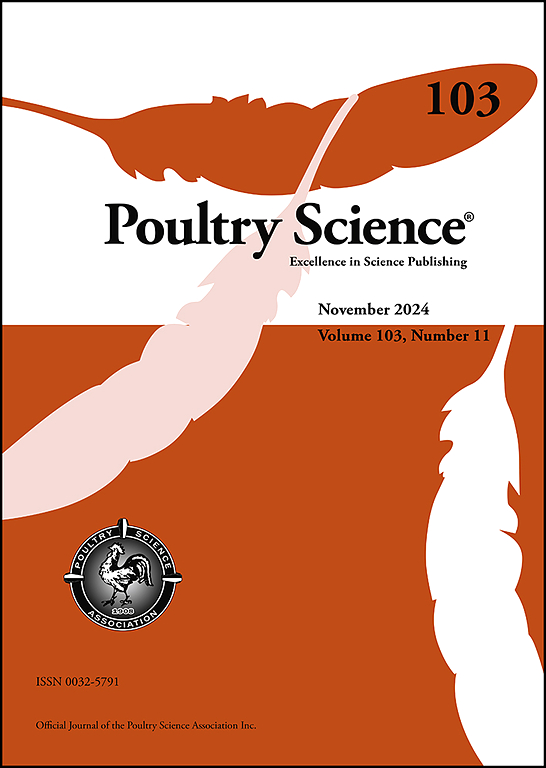肌生成抑制素敲除鸡骨骼肌纤维组成的产后改变
IF 4.2
1区 农林科学
Q1 AGRICULTURE, DAIRY & ANIMAL SCIENCE
引用次数: 0
摘要
在之前的一项研究中,我们在聚集规则间隔短回文重复相关蛋白9 (CRISPR-Cas9)技术产生的肌肉生长抑制素(MSTN)敲除(KO)鸡中发现了一种肌肉纤维增生和肥厚的肌肉过度表型。在哺乳动物中,MSTN缺失导致快速糖酵解纤维的产生增加,同时伴随缓慢氧化纤维的产生减少。然而,MSTN缺失对鸡等禽类肌纤维类型的影响很少被研究。在这项研究中,我们分析了不同年龄的鸡的肌纤维,以研究MSTN缺失是否会改变孵化后的肌纤维组成。对野生型(WT)和MSTN-KO鸡在孵化和10、18周龄时的股二头肌(BF)组织进行atp酶和烟酰胺腺嘌呤二核苷酸氢四氮唑还原酶(NADH-TR)的免疫荧光和组织化学染色。将BF肌纤维分为1、2A、2B三类。在各年龄阶段,MSTN-KO鸡比WT鸡产生更多的肌纤维。MSTN-KO鸡在孵化时未观察到纤维肥大,但在10周和18周时,所有纤维类型均有纤维肥大。与WT鸡相比,MSTN-KO鸡BF组织中1型纤维数量显著减少,2B型纤维数量显著增加,2A型纤维数量保持不变。此外,MSTN缺失导致骨骼肌糖酵解途径基因和MyoD表达上调。因此,MSTN缺失改变了鸡的肌纤维组成,在胚胎阶段诱导2B型纤维优势和增生,而在孵化后,由于营养摄取导致的肌肉肥大成为优势。本文章由计算机程序翻译,如有差异,请以英文原文为准。
Postnatal alterations in skeletal muscle fiber composition of myostatin-knockout chickens
In a previous study, we identified a hypermuscular phenotype attributed to both muscle fiber hyperplasia and hypertrophy in myostatin (MSTN)-knockout (KO) chickens generated by clustered regularly interspaced short palindromic repeats-associated protein 9 (CRISPR-Cas9) technology. In mammals, MSTN deletion results in increased production of fast glycolytic fibers, accompanied by decreased production of slow oxidative fibers. However, the effects of MSTN deletion on muscle fiber types have rarely been studied in avian species such as chickens. In this study, we analyzed muscle fibers in chickens at various ages to investigate whether MSTN deletion alters muscle fiber composition after hatching. Immunofluorescence and histochemical staining, including ATPase and nicotinamide adenine dinucleotide hydrogen–tetrazolium reductase (NADH–TR) staining, were performed on biceps femoris (BF) tissues of wild-type (WT) and MSTN-KO chickens at hatching and at 10 and 18 weeks. BF muscle fibers were classified into three types (1, 2A, and 2B). MSTN-KO chickens produced more muscle fibers than did WT chickens at all ages. Fiber hypertrophy was not observed in MSTN-KO chickens at hatching, but was detected in all fiber types at 10 and 18 weeks. Compared to WT chickens, there was a significant decrease in Type 1 fibers and an increase in Type 2B fibers in the BF tissues of MSTN-KO chickens, whereas the amount of Type 2A fibers remained unchanged. Furthermore, MSTN deletion led to upregulated expression of genes in the glycolytic pathway and MyoD in skeletal muscles. Thus, MSTN deletion altered muscle fiber composition in chickens, inducing Type 2B fiber dominance and hyperplasia during the embryonic stage, whereas muscle hypertrophy due to nutritional uptake became predominant after hatching.
求助全文
通过发布文献求助,成功后即可免费获取论文全文。
去求助
来源期刊

Poultry Science
农林科学-奶制品与动物科学
CiteScore
7.60
自引率
15.90%
发文量
0
审稿时长
94 days
期刊介绍:
First self-published in 1921, Poultry Science is an internationally renowned monthly journal, known as the authoritative source for a broad range of poultry information and high-caliber research. The journal plays a pivotal role in the dissemination of preeminent poultry-related knowledge across all disciplines. As of January 2020, Poultry Science will become an Open Access journal with no subscription charges, meaning authors who publish here can make their research immediately, permanently, and freely accessible worldwide while retaining copyright to their work. Papers submitted for publication after October 1, 2019 will be published as Open Access papers.
An international journal, Poultry Science publishes original papers, research notes, symposium papers, and reviews of basic science as applied to poultry. This authoritative source of poultry information is consistently ranked by ISI Impact Factor as one of the top 10 agriculture, dairy and animal science journals to deliver high-caliber research. Currently it is the highest-ranked (by Impact Factor and Eigenfactor) journal dedicated to publishing poultry research. Subject areas include breeding, genetics, education, production, management, environment, health, behavior, welfare, immunology, molecular biology, metabolism, nutrition, physiology, reproduction, processing, and products.
 求助内容:
求助内容: 应助结果提醒方式:
应助结果提醒方式:


